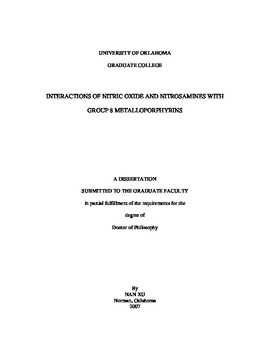| dc.contributor.advisor | Richter-Addo, George B., | en_US |
| dc.contributor.author | Xu, Nan. | en_US |
| dc.date.accessioned | 2013-08-16T12:21:02Z | |
| dc.date.available | 2013-08-16T12:21:02Z | |
| dc.date.issued | 2007 | en_US |
| dc.identifier.uri | https://hdl.handle.net/11244/1314 | |
| dc.description.abstract | Chapter 1 of this dissertation introduces the importance of nitric oxide in biological systems. | en_US |
| dc.description.abstract | Chapter 3 describes the syntheses of new nitrosyl organoruthenium porphyrin complexes (T(p-X)PP)Ru(NO)R (X = OMe, CF3; R = Me, Et) by the reactions of their nitrosyl chloro precursors with alkylating agents Al(R)3 and RMgBr. The nuNO of these nitrosyl organoruthenium complexes and their chloro precursors support the increasing electron donating ability of chloro < aryl < alkyl groups. The (T( p-OMe)PP)Ru(OS(O)Me) compound was obtained by the reaction of SO 2 with (T(p-OMe)PP)Ru(NO)Me. Judging by the lack of reaction between SO2 and (T(p-OMe)PP)Ru(Me) 2, we believe that the nitrosyl group in the (T(p-OMe)PP)Ru(NO)Me imparts a strong trans effect on the ruthenium-carbon bond in (T(p-OMe)PP)Ru(NO)Me weakening the metal-carbon bond. An unusual bent ruthenium-nitrosyl linkage with the angle of 153.0(3)° was observed. The structure reported here is the first organometallic nitrosyl porphyrin with an alkyl group as the axial ligand. Both of the (T( p-OMe)PP)Ru(NO)R compounds display a chemically and electrochemically reversible first oxidation. Infrared spectroelectrochemistry studies indicate a porphyrin-centered first oxidation for both (T(p-OMe)PP)Ru(NO)Et and (T(p-OMe)PP)Ru(NO)Me. | en_US |
| dc.description.abstract | Chapter 2 describes the syntheses of the (por)Ru(NO)X complexes (por = TPP, TTP, T(p-OMe)PP, T(p-CF3)PP, OEP; X = Cl, Br) from the reaction of corresponding (por)Ru(NO)(OR) precursors with boron trichloride or tribromide. The IR spectrum of electron rich octaethyl beta-substituted porphyrin (OEP)Ru(NO)Cl shows the nitrosyl stretch at 1842 cm-1 in CH2Cl2 which is significantly lower than those of other aryl meso-substituted porphyrin derivatives (TTP, T( p-OMe)PP, T(p-CF3)PP). A crystal structure of (OEP)Ru(NO)Cl was obtained and exhibits a linear Ru-NO geometry. Analysis of the electrochemical data reveals that the first oxidations of the (por)Ru(NO)Cl compounds are porphyrin-ring centered. | en_US |
| dc.description.abstract | Chapter 4 describes the syntheses of new bis-nitrosamine iron porphyrin complexes via the reactions of precursor [(por)Fe(THF)2](ClO 4) with nitrosamines (Me2NNO, Et2NNO, ( cyclo-CH2)4NNO, (cyclo-CH 2)5NNO, (PhCH2)2NNO). Interestingly, a sole eta1-O binding mode for nitrosamine iron(III) complexes has been determined by single-crystal X-ray crystallography. In addition, the interactions of three aryl nitrosamines (Ph2NNO, PhMeNNO, PhEtNNO) with four-coordinate iron(II) porphyrin compound resulted in five-coordinate nitrosyl iron porphyrins and the corresponding amines. | en_US |
| dc.description.abstract | Chapter 5 describes the syntheses of a series of iron porphyrin/chlorin complexes containing axial S-bound and O-bound ligands trans to nitric oxide using a unique heterogenous solid-gas method which allows the NO gas to diffuse into the crystals and coordinate to the iron center in a solvent-free environment. This method overcomes synthetic difficulties of {FeNO}6 complexes such as the lability of the Fe-NO linkage, the easy reduction of {FeNO} 6 complexes and fast decomposition in organic solvents. This new method could be used in preparations and structure determinations of many other previously inaccessible complexes. Solid-state structures were obtained for the six-coordinate (OEP)Fe(NO)[S-2,6-(CF3CONH)2C6H3] and (TPC)Fe(NO)(OCOCF3) compounds. Interestingly, the (OEP)Fe(NO)[S-2,6-(CF 3CONH)2C6H3] compound displays an unusual bent metal-nitrosyl linkage (159.6(8)° ), while the (TPC)Fe(NO)(OCOCF 3) compound exhibit the typical linear metal-nitrosyl linkage of {FeNO} 6 complexes. No significant trans effect of NO was observed in (OEP)Fe(NO)[S-2,6-(CF3CONH)2C6H 3] based on the Fe-S bond length change from the five-coordinate precursor to the six-coordinate nitrosyl compounds. In the case of (TPC)Fe(NO)(OCOCF 3), a small trans effect of NO was observed. Additionally, both of the Fe atoms in these two-phase reactions were pulled upwards to nitrosyl groups with remarkable movements of ∼ 0.46 A and ∼ 0.55 A ∼ in solid state respectively. The structure of (OEP)Fe(NO)[S-2,6-(CF3CONH) 2C6H3] is the first reported structure of model complexes of nitrosyl cysteinate heme proteins. The bent FeNO geometry in (OEP)Fe(NO)[S-2,6-(CF3CONH)2C6H3] suggests that the bending of the NO group may be a common feature in the NO adducts of ferric heme thiolate proteins. The (TPC)Fe(NO)(OCOCF3) compound is also the first structurally characterized neutral model complex of nitrosyl tyrosinate heme proteins. The structure displays a typical linear Fe-NO linkage of {FeNO}6 complexes. (Abstract shortened by UMI.) | en_US |
| dc.description.abstract | This dissertation describes the interactions of nitric oxide and nitrosamines with group 8 metalloporphyrins. | en_US |
| dc.format.extent | xv, 125 leaves : | en_US |
| dc.subject | Hemoproteins. | en_US |
| dc.subject | Nitrosoamines. | en_US |
| dc.subject | Chemistry, Inorganic. | en_US |
| dc.subject | Porphyrins. | en_US |
| dc.subject | Nitric oxide. | en_US |
| dc.title | Interactions of nitric oxide and nitrosamines with group 8 metalloporphyrins. | en_US |
| dc.type | Thesis | en_US |
| dc.thesis.degree | Ph.D. | en_US |
| dc.thesis.degreeDiscipline | Department of Chemistry and Biochemistry | en_US |
| dc.note | Adviser: George B. Richter-Addo. | en_US |
| dc.note | Source: Dissertation Abstracts International, Volume: 68-12, Section: B, page: 8026. | en_US |
| ou.identifier | (UMI)AAI3294671 | en_US |
| ou.group | College of Arts and Sciences::Department of Chemistry and Biochemistry | |
